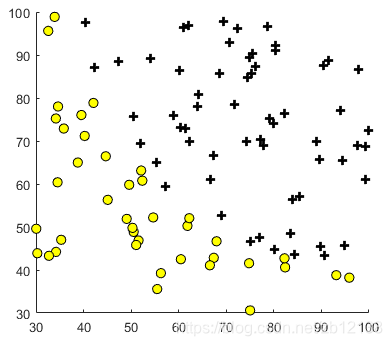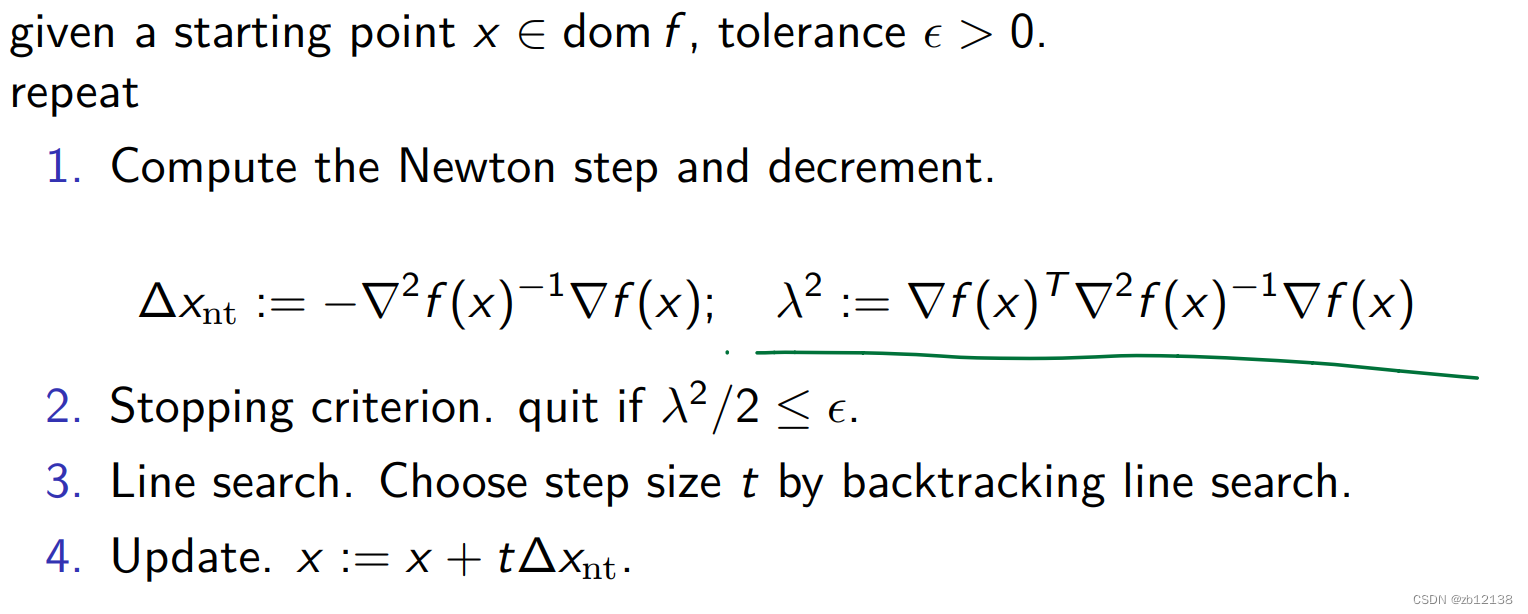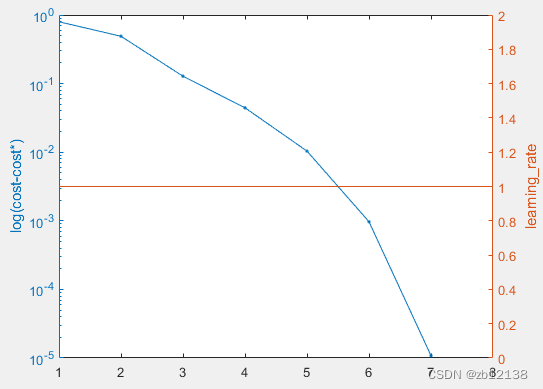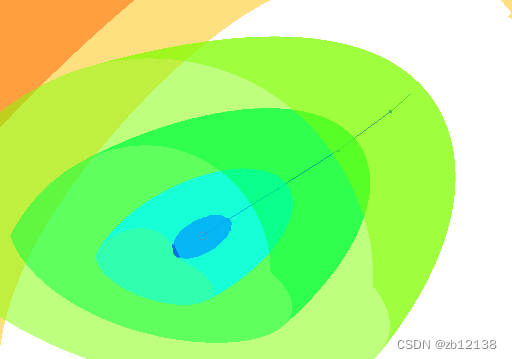前言
本质是一个求函数最小值问题,这个函数在机器学习中称为Logistic回归,一个通用的求解方法称为梯度下降法。
Logistic回归
Logistic回归用于求解分类问题:
设样本x有n个特征,正负两类y(y = 0 或 1)。现已知m个这样的样本构成样本矩阵X(m * n)及它们对应的类别y(m * 1)(数据)。现需要找到一个判别方法(假设)h,用来预测新样本x0对应的类别y0。
Logistic回归的假设是:



即hθ表示样本为正(y=1)的概率,可以认为

其中θ是h的参数即我们的求解目标。x表示一个样本,它与θ都是列向量。具体的:

我们强制引入特征x0 = 1,使得θ0成为偏置。
目前有了假设,我们要求解θ ,需要一个标准来评估求解结果,即损失函数。
不用想都知道它应该是训练集分类错误数的增函数。
天才们把它定义为:

可以验证如果实际y = 1,预测的hθ越大,cost越小,反之(预测错误)cost越大,y = 0也是对的, 而且cost >= 0。
至于为什么这样定义,是方便求导以求θ
评估hθ在全体训练集上的总体效果即把m个样本的cost求均值:

x(i)表示第i个样本,即X(i,:)的转置。
我们的优化目标就是求J(θ)的最小值时θ 为多少。
感谢吴老师的例子,我们在此之上写下这部分matlab代码:
function g = sigmoid(z)
% SIGMOID Compute sigmoid function
% g = SIGMOID(z) computes the sigmoid of z.
g = zeros(size(z));
gt = 1./(1 + exp(-z(:)));
g = reshape(gt,size(z));
end
function p = predict(theta, X)
% PREDICT Predict whether the label is 0 or 1 using learned logistic
% regression parameters theta
% p = PREDICT(theta, X) computes the predictions for X using a
% threshold at 0.5 (i.e., if sigmoid(theta'*x) >= 0.5, predict 1)
p = (sigmoid(theta'*X') >= 0.5)';
end
function [J, grad] = costFunction(theta, X, y)
% COSTFUNCTION Compute cost and gradient for logistic regression
% J = COSTFUNCTION(theta, X, y) computes the cost of using theta as the
% parameter for logistic regression and the gradient of the cost
m = length(y); % number of training examples
h = sigmoid(theta'*X');%h is row vector
J = (-log(h)*y - log(1-h)*(1-y)) /m ;
end
grad = ((h - y')*X /m)' ;
end
梯度下降法
我们知道函数梯度的方向是函数增最快的方向,其增长率等于梯度的模。 反之,我们每次向梯度的发方向更新θ就可能找到极小(最小)值点,在越接近极值时函数变化越慢,模越小,θ变化就越小,这样才能保证收敛。
此处我们需要求J(θ)的梯度,不信可以自己算,J(θ)的梯度如下:

非常的巧妙,这和线性回归的一模一样。
最后梯度下降就是这样,向梯度反方向按α(学习率)比例更新θ直到收敛。

这部分matlab代码如下(J(θ)的梯度计算见costFunction):
function [theta_A,cost_A] = GradientDescent(theta,learning_rate,X,y)
cost = 1;
cost_A = 1;%cost历史
theta_A = theta;%theta历史
while(cost>=0.2036) %此参数可调,目前就这样写吧,因为还没想好怎么判断收敛orz...
[cost,grad] = costFunction(theta, X, y);
theta = theta - learning_rate * grad;
cost_A = [cost_A cost];
theta_A = [theta_A theta];
end
end
其实现在就可以开心计算了。
例子1,固定学习率
下面的例子有个100个样本,2个特征(m=100,n=2),要求解的是一个3*1的θ
样本 ex2data1.txt:
34.62365962451697,78.0246928153624,0
30.28671076822607,43.89499752400101,0
35.84740876993872,72.90219802708364,0
60.18259938620976,86.30855209546826,1
79.0327360507101,75.3443764369103,1
45.08327747668339,56.3163717815305,0
61.10666453684766,96.51142588489624,1
75.02474556738889,46.55401354116538,1
76.09878670226257,87.42056971926803,1
84.43281996120035,43.53339331072109,1
95.86155507093572,38.22527805795094,0
75.01365838958247,30.60326323428011,0
82.30705337399482,76.48196330235604,1
69.36458875970939,97.71869196188608,1
39.53833914367223,76.03681085115882,0
53.9710521485623,89.20735013750205,1
69.07014406283025,52.74046973016765,1
67.94685547711617,46.67857410673128,0
70.66150955499435,92.92713789364831,1
76.97878372747498,47.57596364975532,1
67.37202754570876,42.83843832029179,0
89.67677575072079,65.79936592745237,1
50.534788289883,48.85581152764205,0
34.21206097786789,44.20952859866288,0
77.9240914545704,68.9723599933059,1
62.27101367004632,69.95445795447587,1
80.1901807509566,44.82162893218353,1
93.114388797442,38.80067033713209,0
61.83020602312595,50.25610789244621,0
38.78580379679423,64.99568095539578,0
61.379289447425,72.80788731317097,1
85.40451939411645,57.05198397627122,1
52.10797973193984,63.12762376881715,0
52.04540476831827,69.43286012045222,1
40.23689373545111,71.16774802184875,0
54.63510555424817,52.21388588061123,0
33.91550010906887,98.86943574220611,0
64.17698887494485,80.90806058670817,1
74.78925295941542,41.57341522824434,0
34.1836400264419,75.2377203360134,0
83.90239366249155,56.30804621605327,1
51.54772026906181,46.85629026349976,0
94.44336776917852,65.56892160559052,1
82.36875375713919,40.61825515970618,0
51.04775177128865,45.82270145776001,0
62.22267576120188,52.06099194836679,0
77.19303492601364,70.45820000180959,1
97.77159928000232,86.7278223300282,1
62.07306379667647,96.76882412413983,1
91.56497449807442,88.69629254546599,1
79.94481794066932,74.16311935043758,1
99.2725269292572,60.99903099844988,1
90.54671411399852,43.39060180650027,1
34.52451385320009,60.39634245837173,0
50.2864961189907,49.80453881323059,0
49.58667721632031,59.80895099453265,0
97.64563396007767,68.86157272420604,1
32.57720016809309,95.59854761387875,0
74.24869136721598,69.82457122657193,1
71.79646205863379,78.45356224515052,1
75.3956114656803,85.75993667331619,1
35.28611281526193,47.02051394723416,0
56.25381749711624,39.26147251058019,0
30.05882244669796,49.59297386723685,0
44.66826172480893,66.45008614558913,0
66.56089447242954,41.09209807936973,0
40.45755098375164,97.53518548909936,1
49.07256321908844,51.88321182073966,0
80.27957401466998,92.11606081344084,1
66.74671856944039,60.99139402740988,1
32.72283304060323,43.30717306430063,0
64.0393204150601,78.03168802018232,1
72.34649422579923,96.22759296761404,1
60.45788573918959,73.09499809758037,1
58.84095621726802,75.85844831279042,1
99.82785779692128,72.36925193383885,1
47.26426910848174,88.47586499559782,1
50.45815980285988,75.80985952982456,1
60.45555629271532,42.50840943572217,0
82.22666157785568,42.71987853716458,0
88.9138964166533,69.80378889835472,1
94.83450672430196,45.69430680250754,1
67.31925746917527,66.58935317747915,1
57.23870631569862,59.51428198012956,1
80.36675600171273,90.96014789746954,1
68.46852178591112,85.59430710452014,1
42.0754545384731,78.84478600148043,0
75.47770200533905,90.42453899753964,1
78.63542434898018,96.64742716885644,1
52.34800398794107,60.76950525602592,0
94.09433112516793,77.15910509073893,1
90.44855097096364,87.50879176484702,1
55.48216114069585,35.57070347228866,0
74.49269241843041,84.84513684930135,1
89.84580670720979,45.35828361091658,1
83.48916274498238,48.38028579728175,1
42.2617008099817,87.10385094025457,1
99.31500880510394,68.77540947206617,1
55.34001756003703,64.9319380069486,1
74.77589300092767,89.52981289513276,1
数据加载及可视化:
%% Initialization
clear ; close all; clc
%% Load Data
% The first two columns contains the exam scores and the third column
% contains the label.
data = load('ex2data1.txt');
X = data(:, [1, 2]); y = data(:, 3);
%% ==================== Part 1: Plotting ====================
% We start the exercise by first plotting the data to understand the
% the problem we are working with.
fprintf(['Plotting data with + indicating (y = 1) examples and o ' ...
'indicating (y = 0) examples.\n']);
plotData(X, y);
% Put some labels
hold on;
% Labels and Legend
xlabel('Exam 1 score')
ylabel('Exam 2 score')
% Specified in plot order
legend('Admitted', 'Not admitted')
hold off;
function plotData(X, y)
figure; hold on;
pos = find(y==1); neg = find(y == 0);
% Plot Examples
plot(X(pos, 1), X(pos, 2), 'k+','LineWidth', 2, ...
'MarkerSize', 7);
plot(X(neg, 1), X(neg, 2), 'ko', 'MarkerFaceColor', 'y', ...
'MarkerSize', 7);
hold off;
end
数据可视化结果:

既然是求最小,当然可以用fminunc:
%% ============= Part 2: Optimizing using fminunc =============
% In this exercise, you will use a built-in function (fminunc) to find the
% optimal parameters theta.
% Initialize fitting parameters
[m, n] = size(X);
% Add intercept term to x and X_test
X = [ones(m, 1) X]; % 强制引入特征x0 = 1,使得θ0成为偏置
% Initialize fitting parameters
initial_theta = zeros(n + 1, 1);
% Set options for fminunc
options = optimset('GradObj', 'on', 'MaxIter', 400);
% Run fminunc to obtain the optimal theta
% This function will return theta and the cost
[theta, cost] = ...
fminunc(@(t)(costFunction(t, X, y)), initial_theta, options);
pause;
最优解为
theta = [-25.1613 ; 0.2062 ; 0.2015]
cost = 0.2035
我们用自己写的GradientDescent试试
[theta_A,cost_A] = GradientDescent([0 0 0]',0.001,X,y);%初始点设置为[0;0;0] 学习率0.001大了会翻车!
我们方发现由于固定学习率,此方法非常垃圾,大学习率会导致震荡,小学习率收敛极慢。大概运行2min,实在不确定可以断点看看cost有没有在下降。
这个过程历经600W步,cost变化如下:
plot(cost_A)

可以看出后面cost收敛非常慢。
theta(前两个维度) 变化如下:
[theataX1,theataX2]= meshgrid( -30:0.01*30:30, -10:0.01*5:1);
J = zeros(size(theataX1));
for i = 1:size(theataX1,1)
for j = 1:size(theataX1,2)
theata = [theataX1(i,j),theataX2(i,j),theta(3)]';
J(i,j) = costFunction(theata,X,y);
end
end
contour(theataX1,theataX2,J)
hold on
plot(theta(1),theta(2),'o')
plot(theta_A(1,:),theta_A(2,:),'.-')

可以看出,等高线非常狭长,这是由于没有正则化引起的。
改进1:正则化
数据的不同特征变化范围和对cost影响不一致,导致梯度下降缓慢。我们采取以下方式正则化:

X_ = [X(:,1) (X(:,2) - mean(X(:,2)))/std(X(:,2)) (X(:,3) - mean(X(:,3)))/std(X(:,3))];
先fminunc更新一下标准答案。
theta = [1.7184;4.0129; 3.7439]
cost = 0.2035
重新试验:
[theta_A,cost_A] = GradientDescent([0 0 0]',0.001,X_,y);
这次仅需要30W步,cost变化形状如上,θ变化如下:

可以看出,正则化后特征变得均匀。
改进2:动态学习率
如果我们每次能动态调整学习率,使得其为最佳,岂不是可以更快。
以下x实则为θ,请勿与样本混淆。

即g已经在上面costFunction算出来了,grad,只需计算Hessian矩阵H便大功告成了。

那么在此列Logistic回归中H是个3*3的矩阵,它是多少呢:

可以看出Hij = Hji 它的确是一个对称矩阵。
下面是matlab实现,有个技巧是每行代表一个样本。
function hessian= Hessian(theta, X)
n = length(theta);
hessian= zeros(n);
h = sigmoid(theta'*X')';
for j = 1:n
for i = 1:j
hessian(i,j) = mean(X(:,j).* X(:,i).*h.*(1-h));
hessian(j,i) = hessian(i,j);
end
end
end
这次我们把收敛条件放严格while(cost>=0.2035)
重写GradientDescent的学习率部分为GradientDescent2:
function [theta_A,cost_A,learning_rate_A] = GradientDescent2(theta,X,y)
cost = 1;
cost_A = 1;
theta_A = theta;
learning_rate_A= 0.001;
while(cost>=0.2035)
[cost,grad] = costFunction(theta, X, y);
learning_rate = grad'*grad/(grad'*Hessian(theta,X)*grad);%动态学习率
theta = theta - learning_rate * grad;
learning_rate_A = [learning_rate_A learning_rate];
cost_A = [cost_A cost];
theta_A = [theta_A theta];
end
cost
end
测试一下:
[theta_A,cost_A,learning_rate_A] = GradientDescent([0 0 0]',X_,y);
结果只用了33步!
学习率和cost变化如下:

θ变化如下:

其中的折线似乎不按梯度方向,实际是三维投影在θ前两维的效果。三维空间中θ实际路径如下:

改进3 牛顿法

function [theta_A,cost_A,learning_rate_A] = NewtonMethod(theta,X,y)
cost = 1;
cost_A = 1;
theta_A = theta;
learning_rate_A = 1;
while(cost>=0.2035)
[cost,grad] = costFunction(theta, X, y);
delta_theta_nt = -Hessian(theta,X)^(-1)*grad;
learning_rate= 1;
[cost_new,g] = costFunction(theta+ learning_rate* delta_theta_nt, X, y);
while(cost_new>=cost + 1/2*learning_rate*grad'*delta_theta_nt) % backtracking line search
learning_rate = 1/2*learning_rate;
[cost_new,g] = costFunction(theta+ learning_rate* delta_theta_nt, X, y);
end
theta = theta + learning_rate* delta_theta_nt;
learning_rate_A = [learning_rate_A learning_rate];
cost_A = [cost_A cost];
theta_A = [theta_A theta];
end
disp('final loss')
disp(cost)
end
平方收敛速度,只用7步!



查看分类效果
临界点为h = 0.5 即 θ0+ θ1x1 + θ2x2 =0
plotData(X_(:,2:3),y);
plot_x = [min(X_(:,2))-0.5, max(X_(:,2))+0.5];
% Calculate the decision boundary line
plot_y = (-1./theta(3)).*(theta(2).*plot_x + theta(1));
hold on
plot(plot_x, plot_y)

不足
没有收敛判别
在大的初值下会溢出无法运算
完整代码
%% Initialization
clear ; close all; clc
% Load Data
% The first two columns contains the exam scores and the third column
% contains the label.
data = load('ex2data1.txt');
X = data(:, [1, 2]); y = data(:, 3);
%% ==================== Part 1: Plotting ====================
% We start the exercise by first plotting the data to understand the
% the problem we are working with.
fprintf(['Plotting data with + indicating (y = 1) examples and o ' ...
'indicating (y = 0) examples.\n']);
plotData(X, y);
% Put some labels
hold on;
% Labels and Legend
xlabel('Exam 1 score')
ylabel('Exam 2 score')
% Specified in plot order
legend('Admitted', 'Not admitted')
hold off;
fprintf('\nProgram paused. Press enter to continue.\n');
%% ============ Part 2: Compute Cost and Gradient ============
% In this part of the exercise, you will implement the cost and gradient
% for logistic regression. You neeed to complete the code in
% costFunction.m
% Setup the data matrix appropriately, and add ones for the intercept term
[m, n] = size(X);
% Add intercept term to x and X_test
X = [ones(m, 1) X];
% Initialize fitting parameters
initial_theta = zeros(n + 1, 1);
% Compute and display initial cost and gradient
[cost, grad] = costFunction(initial_theta, X, y);
fprintf('Cost at initial theta (zeros): %f\n', cost);
fprintf('Expected cost (approx): 0.693\n');
fprintf('Gradient at initial theta (zeros): \n');
fprintf(' %f \n', grad);
fprintf('Expected gradients (approx):\n -0.1000\n -12.0092\n -11.2628\n');
% Compute and display cost and gradient with non-zero theta
test_theta = [-24; 0.2; 0.2];
[cost, grad] = costFunction(test_theta, X, y);
fprintf('\nCost at test theta: %f\n', cost);
fprintf('Expected cost (approx): 0.218\n');
fprintf('Gradient at test theta: \n');
fprintf(' %f \n', grad);
fprintf('Expected gradients (approx):\n 0.043\n 2.566\n 2.647\n');
fprintf('\nProgram paused. Press enter to continue.\n');
%% ============= Part 3: Optimizing using fminunc =============
% In this exercise, you will use a built-in function (fminunc) to find the
% optimal parameters theta.
% Set options for fminunc
options = optimset('GradObj', 'on', 'MaxIter', 400);
% Run fminunc to obtain the optimal theta
% This function will return theta and the cost
[theta, cost] = ...
fminunc(@(t)(costFunction(t, X, y)), initial_theta, options);
% Print theta to screen
fprintf('Cost at theta found by fminunc: %f\n', cost);
fprintf('Expected cost (approx): 0.203\n');
fprintf('theta: \n');
disp('find the optimal solution:')
disp(theta)
fprintf('Expected theta (approx):\n');
fprintf(' -25.161\n 0.206\n 0.201\n');
% Plot Boundary
plotDecisionBoundary(theta, X, y);
% Put some labels
hold on;
% Labels and Legend
xlabel('Exam 1 score')
ylabel('Exam 2 score')
% Specified in plot order
legend('Admitted', 'Not admitted')
hold off;
fprintf('\nProgram paused. Press enter to continue.\n');
%% ============== Part 4: Predict and Accuracies ==============
% After learning the parameters, you'll like to use it to predict the outcomes
% on unseen data. In this part, you will use the logistic regression model
% to predict the probability that a student with score 45 on exam 1 and
% score 85 on exam 2 will be admitted.
%
% Furthermore, you will compute the training and test set accuracies of
% our model.
%
% Your task is to complete the code in predict.m
% Predict probability for a student with score 45 on exam 1
% and score 85 on exam 2
prob = sigmoid([1 45 85] * theta);
fprintf(['For a student with scores 45 and 85, we predict an admission ' ...
'probability of %f\n'], prob);
fprintf('Expected value: 0.775 +/- 0.002\n\n');
% Compute accuracy on our training set
p = (sigmoid(theta'*X') >= 0.5)';
fprintf('Train Accuracy: %f\n', mean(double(p == y)) * 100);
fprintf('Expected accuracy (approx): 89.0\n');
fprintf('\n');
%% ============== Part 5: Original Gradient Descent Method ==============
% it takes about 2 minutes
% [theta_H,cost_H] = GradientDescent([0 0 0]',0.001,X,y); %The initial point is set to[0;0;0] learning rate 0.001, error if it is too large!
% figure();
% plot(cost_H)
% xlabel('steps'), ylabel('cost')
% viewGradient(theta_H(:,end),theta_H,X,y,-30:0.1*30:30,-10:0.1*5:1);
% disp('find the optimal solution:')
% disp(theta_H(:,end))
%% ============== Part 6: Improvement 1, normalization ==============
X2 = [X(:,1) (X(:,2) - mean(X(:,2)))/std(X(:,2)) (X(:,3) - mean(X(:,3)))/std(X(:,3))];
[theta_H,cost_H] = GradientDescent([0 0 0]',0.001,X2,y);
figure();
plot(cost_H)
xlabel('steps'), ylabel('cost')
viewGradient(theta_H(:,end),theta_H,X2,y,-5:0.1:5,-1:0.1:5);
disp('find the optimal solution:')
disp(theta_H(:,end))
%% ============== Part 7: Improvement 2, Best Learning Rate by Hessian ==============
[theta_H,cost_H,learning_rate_H] = GradientDescent2([0 0 0]',X2,y);
figure();
yyaxis left
plot(cost_H,'.-')
ylabel('cost')
yyaxis right
plot(learning_rate_H)
ylabel('learning\_rate')
viewGradient(cost_H,theta_H(:,end),theta_H,X2,y,-5:0.1:5,-1:0.1:5);
viewGradientXZ(cost_H,theta_H(:,end),theta_H,X2,y,-5:0.1:5,0:0.05:5);
viewGradient3D(cost_H,theta_H(:,end),theta_H,X2,y,-5:0.1:5,-1:0.1:5,0:0.05:5);
disp('find the optimal solution:')
disp(theta_H(:,end))
%% ============== Part 8: Newton's method ==============
[theta_H,cost_H,learning_rate_H] = NewtonMethod([0 0 0]',X2,y);
figure();
yyaxis left
semilogy(cost_H-0.2035,'.-')
ylabel('log(cost-cost*)')
yyaxis right
plot(learning_rate_H)
ylabel('learning\_rate')
viewGradient(cost_H,theta_H(:,end),theta_H,X2,y,-5:0.1:5,-1:0.1:5);
viewGradientXZ(cost_H,theta_H(:,end),theta_H,X2,y,-5:0.1:5,0:0.05:5);
viewGradient3D(cost_H,theta_H(:,end),theta_H,X2,y,-5:0.1:5,-1:0.1:5,0:0.05:5);
disp('find the optimal solution:')
disp(theta_H(:,end))
%%
[cost,grad] = costFunction(theta_H(:,5), X, y);
%%
%% core functions
function g = sigmoid(z)
%SIGMOID Compute sigmoid function
% g = SIGMOID(z) computes the sigmoid of z.
% You need to return the following variables correctly
g = zeros(size(z));
% ====================== YOUR CODE HERE ======================
% Instructions: Compute the sigmoid of each value of z (z can be a matrix,
% vector or scalar).
gt = 1./(1 + exp(-z(:)));
g = reshape(gt,size(z));
% =============================================================
end
function [J, grad] = costFunction(theta, X, y)
% COSTFUNCTION Compute cost and gradient for logistic regression
% J = COSTFUNCTION(theta, X, y) computes the cost of using theta as the
% parameter for logistic regression and the gradient of the cost
m = length(y); % number of training examples
h = sigmoid(theta'*X');%h is row vector
J = (-log(h)*y - log(1-h)*(1-y)) /m ;
grad = ((h - y')*X /m)' ;
end
function [theta_A,cost_A] = GradientDescent(theta,learning_rate,X,y)
cost = 1;
cost_A = 1;%cost history
theta_A = theta;%theta history
while(cost>=0.2036) % convergence judge
[cost,grad] = costFunction(theta, X, y);
theta = theta - learning_rate * grad;
cost_A = [cost_A cost];
theta_A = [theta_A theta];
end
end
function [theta_A,cost_A,learning_rate_A] = GradientDescent2(theta,X,y)
cost = 1;
cost_A = 1;
theta_A = theta;
learning_rate_A= 0.001;
while(cost>=0.2035)
[cost,grad] = costFunction(theta, X, y);
learning_rate = grad'*grad/(grad'*Hessian(theta,X)*grad);% dynamic learning rate
theta = theta - learning_rate * grad;
learning_rate_A = [learning_rate_A learning_rate];
cost_A = [cost_A cost];
theta_A = [theta_A theta];
end
disp('final loss')
disp(cost)
end
function [theta_A,cost_A,learning_rate_A] = NewtonMethod(theta,X,y)
cost = 1;
cost_A = 1;
theta_A = theta;
learning_rate_A = 1;
lamda2 = 1;
while(lamda2/2>=10^(-10))
[cost,grad] = costFunction(theta, X, y);
delta_theta_nt = -Hessian(theta,X)^(-1)*grad;
learning_rate= 1;
[cost_new,g] = costFunction(theta+ learning_rate* delta_theta_nt, X, y);
while(learning_rate>0 && cost_new>=cost + 1/2*learning_rate*grad'*delta_theta_nt) % backtracking line search
learning_rate = 1/2*learning_rate;
[cost_new,g] = costFunction(theta+ learning_rate* delta_theta_nt, X, y);
end
theta = theta + learning_rate* delta_theta_nt;
lamda2 = -g'*delta_theta_nt;
learning_rate_A = [learning_rate_A learning_rate];
cost_A = [cost_A cost];
theta_A = [theta_A theta];
end
disp('final loss')
disp(cost)
end
function hessian= Hessian(theta, X)
n = length(theta);
hessian= zeros(n);
h = sigmoid(theta'*X')';
for j = 1:n
for i = 1:j
hessian(i,j) = mean(X(:,j).* X(:,i).*h.*(1-h));
hessian(j,i) = hessian(i,j);
end
end
end
%% helper functions
function plotData(X, y)
figure; hold on;
pos = find(y==1); neg = find(y == 0);
% Plot Examples
plot(X(pos, 1), X(pos, 2), 'k+','LineWidth', 2, ...
'MarkerSize', 7);
plot(X(neg, 1), X(neg, 2), 'ko', 'MarkerFaceColor', 'y', ...
'MarkerSize', 7);
hold off;
end
function viewGradient(cost_H,theta_target,theta_history,X,y, viewX,viewY)
[thetaX1,thetaX2]= meshgrid(viewX,viewY);
J = zeros(size(thetaX1));
for i = 1:size(thetaX1,1)
for j = 1:size(thetaX1,2)
theta = [thetaX1(i,j),thetaX2(i,j),theta_target(3)]';
J(i,j) = costFunction(theta,X,y);
end
end
figure();
contour(thetaX1,thetaX2,J,cost_H)
hold on
plot(theta_target(1),theta_target(2),'o')
plot(theta_history(1,:),theta_history(2,:),'.-')
xlabel('theta1')
ylabel('theta2')
hold off
end
function viewGradientXZ(cost_H,theta_target,theta_history,X,y, viewX,viewZ)
[thetaX1,thetaX2]= meshgrid(viewX,viewZ);
J = zeros(size(thetaX1));
for i = 1:size(thetaX1,1)
for j = 1:size(thetaX1,2)
theta = [thetaX1(i,j),theta_target(2),thetaX2(i,j)]';
J(i,j) = costFunction(theta,X,y);
end
end
figure();
contour(thetaX1,thetaX2,J,sort(cost_H))
hold on
plot(theta_target(1),theta_target(3),'o')
plot(theta_history(1,:),theta_history(3,:),'.-')
xlabel('theta1')
ylabel('theta3')
hold off
end
function viewGradient3D(cost_H,theta_target,theta_history,X,y, viewX,viewY,viewZ)
[thetaX1,thetaX2,thetaX3]= meshgrid(viewX,viewY,viewZ);
J = zeros(size(thetaX1));
for i = 1:size(thetaX1,1)
for j = 1:size(thetaX1,2)
for k = 1:size(thetaX1,3)
theta = [thetaX1(i,j,k),thetaX2(i,j,k),thetaX3(i,j,k)]';
J(i,j,k) = costFunction(theta,X,y);
end
end
end
figure();
hold on
V = cost_H;
c = hsv(length(V));
for i = 1:length(V)
v = V(i);
s = isosurface(thetaX1,thetaX2,thetaX3,J,v,ones(size(J))*v);
p = patch(s);
isonormals(thetaX1,thetaX2,thetaX3,J,p)
view(3);
set(p,'FaceColor',c(i,:));
set(p,'EdgeColor','none');
set(p,'FaceAlpha',0.5);
% camlight;
% lighting gouraud;
end
axis equal
plot3(theta_history(1,:),theta_history(2,:),theta_history(3,:),'.-')
plot3(theta_target(1),theta_target(2),theta_target(3),'o')
hold off
end
function plotDecisionBoundary(theta, X, y)
%PLOTDECISIONBOUNDARY Plots the data points X and y into a new figure with
%the decision boundary defined by theta
% PLOTDECISIONBOUNDARY(theta, X,y) plots the data points with + for the
% positive examples and o for the negative examples. X is assumed to be
% a either
% 1) Mx3 matrix, where the first column is an all-ones column for the
% intercept.
% 2) MxN, N>3 matrix, where the first column is all-ones
% Plot Data
plotData(X(:,2:3), y);
hold on
if size(X, 2) <= 3
% Only need 2 points to define a line, so choose two endpoints
plot_x = [min(X(:,2))-2, max(X(:,2))+2];
% Calculate the decision boundary line
plot_y = (-1./theta(3)).*(theta(2).*plot_x + theta(1));
% Plot, and adjust axes for better viewing
plot(plot_x, plot_y)
% Legend, specific for the exercise
legend('Admitted', 'Not admitted', 'Decision Boundary')
axis([30, 100, 30, 100])
else
% Here is the grid range
u = linspace(-1, 1.5, 50);
v = linspace(-1, 1.5, 50);
z = zeros(length(u), length(v));
% Evaluate z = theta*x over the grid
for i = 1:length(u)
for j = 1:length(v)
z(i,j) = mapFeature(u(i), v(j))*theta;
end
end
z = z'; % important to transpose z before calling contour
% Plot z = 0
% Notice you need to specify the range [0, 0]
contour(u, v, z, [0, 0], 'LineWidth', 2)
end
hold off
end
参考文献
[1] 吴恩达 机器学习 课程
[2] 深度学习(Deep Learning) Yoshua Bengio & Ian GoodFellow中文版






















 3万+
3万+











 被折叠的 条评论
为什么被折叠?
被折叠的 条评论
为什么被折叠?










